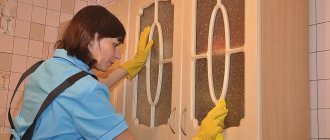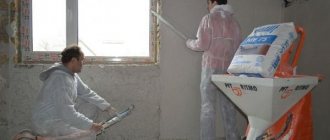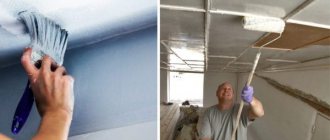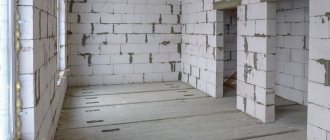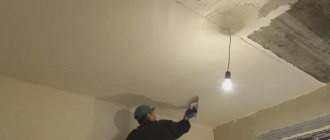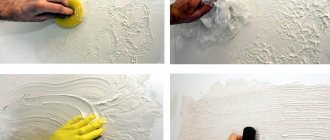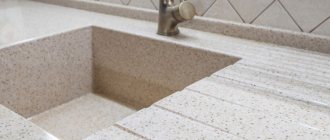Painting technique: existing options
When using a roller, you should pay attention to the quality of painting: a lack of paint on the tool can lead to the formation of unpainted areas that are difficult to notice during the work process.
Such “bald spots” will have to be duplicated with an additional layer of paint, since dotted strokes will stand out from the overall uniformity of the coating. A common method of working with a roller is the “W” technique: vertical stripes slightly overlap each other at the junction, allowing you to quickly paint a large area. The speed of painting using this method does not allow the paint to dry before the end of the work, which makes the resulting layer even and visually consistent.
Painting with a “W” requires plenty of room to manipulate, so it’s best to do it in an empty room. The long handle of the roller makes it especially convenient.
Another way to avoid gaps and stripes is the “squares” technique. It consists of conditionally dividing the wall into squares at the corners, which are painted alternately, and then connected into a single covering with horizontal stripes. This method depends on the illumination of the room and takes into account the direction of light from the window.
Painting in “squares” requires speed to avoid premature drying, so it is more often used by professionals. Hobbyists need to monitor the degree of drying of the paint in order to prevent the coating from being applied to an area that has already dried.
Textured rollers - understanding the variety of species
How to use this tool, and where is it used? The surface of the structural (relief) rollers is made in the form of various patterns. Their very name suggests that they are intended for creating decorative coatings. To create the most uniform pattern on the surface, the structural roller must be rolled in different directions, while trying to maintain uniform pressure.
Working with a structural roller involves forming a three-dimensional pattern on decorative plaster. There are two types of tools: soft - made of foam rubber or fabric, and hard - made of rubber. A texture roller is used if it is necessary to level a surface covered with liquid wallpaper.
Most often, rollers with a textured surface are used to create a uniform relief pattern on wet plaster; its depth does not exceed 5 mm. They are made from wood, linoleum or rubber. To achieve a textured effect, use a figured roller. You can even do it yourself. To do this, the surface of the sleeve should be tied in several places with thread.
If you have a foam roller, use a knife to cut out the simplest pattern on its surface. A structural rubber roller is usually used indoors for applying dispersion paints. With their help, a coating with a pronounced relief structure is formed.
Roller selection
The whole variety of rollers is based on the difference in their purposes (use for different paints and varnishes, surfaces, areas of the surface to be painted).
Size
The rollers are divided into three types based on size.
- Mini - designed for local work in small areas, in corners, for stencils. Also, mini rollers with a rubberized base are used to strengthen seams, increasing the adhesion of the coating to the wall.
- Midi - medium-sized rollers, convenient for most painting tasks. They are used when painting walls, floors, ceilings, and the correct selection of a coat allows you to work with all types of paint.
- Maxi are large rollers, when using which it is difficult to monitor the uniformity of application and the absence of gaps. Maxi-rollers are used in priming work on large areas, as well as in creating a primary coating layer that will be covered by subsequent finishing.
A variety of roller sizes is also observed in the range of highly specialized rollers for uneven surfaces, aggressive paint compositions, structural paint or bitumen.
Foam rubber
It is highly absorbent and suitable for painting most surfaces. The foam nozzle is chosen for water-based or adhesive-based paints and varnishes.
You cannot use a foam roller with water-based or oil-based compositions, as during operation they will destroy the structure of the material, which will lead to the formation of lumps on the paint.
Velours
Gives a smooth surface, used for ceilings or as a finishing layer on walls. Velor is suitable for using water-based and oil-based paints, but it does not absorb solutions well, which is why you have to often draw paint from a tray.
Polyamide
Synthetic coats for rollers are universal: they are suitable for all types of paint and varnish compositions, are not afraid of aggressive solvents, and absorb and release paint. In addition, polyamide rollers are easy to clean after painting, so they last a long time.
Fur
Fur rollers vary in degree of fluffiness and give excellent results even on uneven walls due to the length of the pile. Fur coats (artificial or natural) are used for water-dispersion, oil, alkyd compounds, and are distinguished by the application of coatings without splashing. Fur rollers help create an even layer of paint even on surfaces with cracks, differences, or chips. Suitable for painting large areas.
How to choose the right paint
Structural paints are one of the increasingly popular finishing materials. They are applied in different ways and different types are also needed for certain rooms. Painting mixtures for living rooms (bedroom, living room, nursery) are selected with the texture of silk, velvet; it is recommended to paint the ceilings in light colors, but it is better to keep the relief as minimal as possible. A bulk water emulsion is best.
Wet areas of the bathroom, toilet, and combined bathroom are decorated with waterproof compounds. In the kitchen, especially in the work area, the likelihood of contamination is high; it is recommended to use washable surfaces. The external parts of buildings of any type are often exposed to temperature changes, precipitation, and sunlight. For facades, the most resistant brands of dyes are used - vinyl is optimal, but acrylic is undesirable, since it fades in the sun in just one or two seasons.
How to paint walls correctly
The selection of roller also depends on the type of paint and varnish applied. Each paint has features, timely consideration of which will make the work with a roller high-quality and effective.
Water-based paint
The optimal choice for water-based emulsion will be rollers coated with velor or pile.
Velor coats have weak absorbent power, so they are better suited for small surfaces to be painted.
Pile rollers are an expensive option (especially those made from natural materials), but they have a number of advantages:
- the ability to select the length of the pile to create layers of a certain thickness (for thin - short pile, for thick - long);
- used for uniform painting of walls and for decorative finishing;
- long-term operation;
- the presence of a special elongated pile for porous, rough surfaces.
Enamel
Enamel paint is used to obtain a glossy surface, so the requirements are for the initial smoothness of the wall and for the roller material, which should not leave particles or air bubbles. Creating a glossy coating requires a large-sized natural wool roller - this will allow you to have time to apply the enamel without drying out streaks.
Silicate paint
The peculiarity of applying silicate paint with a roller is that the coat material must pick up and release the same amount of solution from strip to strip, otherwise the difference in the thickness of the layers will be noticeable visually. For silicate compositions, synthetic rollers and special trays with a place for rolling out in the form of a mesh are selected, which removes unnecessary excess.
Other types of paints
The modern variety of types of paint and varnish materials can create difficulties when choosing a roller. In this case, it is better to contact a consultant in the store, who will select a tool taking into account the characteristics of the paint. In addition, it is worth paying attention to the instructions for use, which should list the compositions suitable for the roller. So, for painting walls with latex paint, a roller with minimal synthetic bristles is better suited, and when applying alkyd mixtures, you cannot do without a brush, which should also match the markings.
Materials for making decorative rollers
Modern instruments differ in the type of material they use. Today the following types of decorative rollers are available on the market:
- Rubber cover. On the base of the tool there are protrusions with depressions of various shapes and sizes, thanks to which a pattern or texture is created on the surface. For example, imitation of a relief plane with patterns, brickwork, etc. But such a tool is suitable only for experienced craftsmen, because it requires certain skills in operation.
- Wooden base. Such texture tools are best used for painting walls in children's rooms, since wood is considered an environmentally friendly material, and therefore does not emit harmful substances when used. It can also be used to create original convex patterns and ornaments on a painted surface. But there is one significant drawback - a wooden roller, unlike its rubber counterpart, can swell during operation. To avoid this, the instrument must be thoroughly cleaned and dried after each use.
- Leather base. With it you can give the surface a marble effect. An excellent choice would be a tool with a base made of genuine leather. If we are talking about applying Venetian plaster, then it will become an indispensable assistant.
- Plastic base. Not the best option. The thing is that with prolonged use, the plastic base can crack, thereby ruining the pattern on the surface of the walls. If you decide to use it, you must remember that textured plaster can only be applied on a perfectly smooth surface.
- Pile base. The roller cover is made of synthetic or natural fur with fibers of various lengths. When choosing this type of tool, you must remember that the longer the fibers, the rougher the surface will be and the more patterned the inclusions on the wall will be. It is recommended to give preference only to high-quality tools with reliable fastening of the fibers.
There are also analogues with a base made of foam rubber, polystyrene foam and fabric. Foam rubber options are used for priming the first layer for subsequent application of decor. They are also great for creating bubbles on the surface. Fabric analogues, for the manufacture of which plush soft fabric is used, form relief marks (patterns) on the wall. Devices with a foam base resemble a rubber counterpart. But you need to remember that polystyrene foam is short-lived.
Why streaks and streaks appear: expert advice
To avoid defective areas on the surface to be painted, you must follow a number of mandatory instructions for working with the roller.
- The fur coat should be checked for the quality of the pile in the store (a quality tool is when, when held with the palm of your hand, the structure returns to its original form; with a slight twitch, the hairs of the fur coat do not separate from the roller).
- The metal frame of the roller should not have any extraneous stains of old paint or rust; the rotation mechanism must be smooth and free.
- Despite the fact that a roller allows you to quickly paint a surface, when working with a specific paint composition it is necessary to calculate the exact drying time. Stains and stripes most often form at the junctions of different layers, so following the technologies for paints, varnishes, and liquid wallpaper will help avoid poor-quality results.
Thus, using a paint roller is the best option for combining price and quality: the tool does not require large financial costs, is suitable for all surfaces and is easy to use.
Painting walls: 10 mistakes you should know about
Tips If you have to paint walls during renovation, take into account all the pitfalls of doing it yourself - so that in the end it doesn’t turn out that the surface is painted unevenly, and the paint turns into a lump
If you think that painting takes a maximum of half an hour and the walls become like new, we will have to disappoint you. Painting a surface is a job that is not without its nuances: the process can be delayed due to the wrong paint, roller, or layer applied at the wrong time. The time of day at which you pick up the instrument also matters. Training, of course, is the best way to achieve success, but we recommend avoiding the mistakes of others - we’ll tell you how.
Wall painting process
Painting the walls with water-based paint, done in three layers. To do this, we will need the following working tools: a paint roller, a paint brush, a cuvette (paint bath), a small lamp with an extension cord, a stepladder or a telescopic rod. You can use a spray gun, but not everyone has such a unit on their farm, and purchasing it to paint walls in a small apartment is expensive.
Painted walls with water-based paint design photo ideas
Painting the walls starts from the lighter areas of the rooms to the darker ones, that is, from the windows. To do this, take a roller, pour the previously prepared paint into the cuvette, then thoroughly soak the paint roller in the paint, and roll it over the ribbed part of the cuvette to distribute the paint evenly. It is important to know that if you need to give the walls the effect of an orange peel, then you should choose a roller with a fur coat, but if you just have smooth walls, then it is enough to use a roller with a regular coat.
When painting, do not try to immediately make a saturated color, since after the paint dries, paint joints may remain noticeable; the best option is to make the tone a little lighter, while painting them in several layers. To better control the color and tone of the paint, use additional lighting.
How to paint walls with water-based paint yourself video
Don't try to put a lot of paint on the roller, as the paint will start to splatter. Walls should be painted with water-based paint in parallel stripes, up and down; painting in zigzags is not allowed. Use a brush to paint the corners. Please note that paint the wall only after painting the ceiling.
Mistake #1: Painting unprepared walls
Minor defects, dust, grains of sand, and brush fluff from a previous painting may appear under the paint and negatively affect the result. All the imperfections will be visible under the layer of paint - all you have to do is either accept it or clean the wall and paint it again. And possible greasy stains will appear, no matter how many layers you cover the surface. Defects will be especially noticeable if you use glossy paint.
What to do: To avoid double work and unpleasant surprises, prepare the wall in advance. Take sandpaper or a special plaster sanding tool and go over the uneven areas and defects. Afterwards, brush off the dust with a brush or broom. Stains can be removed by wiping the wall with a damp cloth and soap.
How to repaint it yourself?
Over time, the paint crumbles and burns. If the surface is flat, then removing the old layer is not a problem. It is much more difficult to repaint a relief surface. But in both cases, the plaster needs to be treated for painting:
- Clean old plaster from dust and dirt. The non-moisture resistant paint coating is removed with a spatula, a steam generator or by wetting it with water.
- Then apply primer. It is advisable to take white or a composition with pigment to avoid unpainted colors.
- Now we paint the walls in any convenient way.
Primer is necessary for strong adhesion of new paint and old surface.
Kitchen interior with decorative plaster
Mistake #2: Ignoring Primer
Don't use primer before painting walls? Don't be surprised if you end up with an unevenly painted wall or overused paint. The fact is that the primer provides a lower hygroscopicity of the surface, which allows you to save paint. The base also gives the surface “adhesion” to the paint, which improves the painting of walls.
What to do: Choose the appropriate primer for the walls. Apply it with a brush vertically in small stripes, and then horizontally - perpendicular to the first layer. After the base has dried, you can cover the surface with the first layer of paint.
Mistake #3: Incorrectly thinned paint
The paint can be too thick in consistency or becomes so during the work process. Then it needs to be diluted - this is an intuitive action. But what to dilute with is a question that can ruin both the material and the whole work. For example, if water-dispersion paint is diluted with white spirit, it will cause the polymers to stick together. If you paint a wall with this composition, the result will be of poor quality - disappointment is inevitable: the paint will lie unevenly, maybe even in lumps. If, on the contrary, you dilute oil paint with water, it simply will not mix with the main mass.
What to do: read the composition on the paint can and select the product you will use to dilute the product accordingly. Do not add too much water or solvent - it is better to add a little at a time, thoroughly mixing the paint.
Mistake #4: painting without testing
Choosing a color is a rather complicated process, especially if the shade has to be combined with another tone or pattern. The unfortunate masterpiece will have to be repainted, and so the process can be repeated ad infinitum. The same applies to the shade, which you have to “extract” with your own hands using a color scheme.
What to do: add coloring concentrate to the paint a little at a time, mixing the contents thoroughly. To begin, pour a small amount of paint into a small container and add a couple of drops of color – see what color you get. Achieve the desired tone, and then do the same in a larger jar if you like the result. To make sure the color is compatible with the overall decor of the room, try painting it - apply the paint in an inconspicuous corner and wait until it dries. If the result suits you, let's get going.
Mistake #5: choosing the wrong tool
Using the right brush or roller is just as important as choosing your paint. And this is not a matter of taste. In order to paint the wall evenly, you need to purchase a couple of rollers and a brush. You will be the first to “roll” the surface, and use a brush to paint corners and hard-to-reach places.
What to do: for the first layer of paint, it is better to choose a roller with a long pile - 1–1.5 cm. It will pick up more paint, which will make it faster and easier to obtain uniform coloring. For re-painting, a roller with a short pile of 6–7 mm is more suitable: it will help you use the paint more economically and will definitely not leave “drips”. Choose a brush with natural bristles - it will not leave lint on the surface.
Textured rollers for decorative plaster and wall painting
A textured roller for decorative plaster or painting a wall surface is a special type of tool that comes in a wide variety. You can buy it ready-made or make it yourself using an old roller and scrap materials as a base.
A textured roller is a great way to decorate a surface without resorting to too complex and expensive technologies. And in order to see how unusual and beautiful the effect of using a textured roller for painting walls can be, just look at the photo examples presented on the Internet.
Using a textured roller you can quickly give decorative plaster the desired pattern.
How to choose the right roller for painting ceilings and walls: expert advice
A huge selection of different rollers can confuse almost anyone
So, in order not to make a mistake in your choice, you should once again pay attention to all the important aspects and follow the following recommendations from experts:
- Before you buy a roller, check it directly in the store. To do this, wrinkle the fur coat with force and evaluate the deformation. If the fur coat is too wrinkled, then it is better not to buy such a roller;
- When purchasing a roller with long pile, the coat must first be inspected to make sure that the fibers do not fall out. Otherwise, you will have to deal with hairs on the surface of the painted wall or ceiling;
For high-quality surface painting, when purchasing a lint roller
it is necessary to pay attention to the quality of pile fastening
if you are not sure which roller is suitable for which paint, it is best to give preference to a universal option, which is, for example, polyamide rollers; if you have to paint the walls in an apartment, then a roller with a short handle will be enough
But if you pay attention to how to properly paint the ceiling with a roller, you will see that there are special telescopic handles for this; the roller clasp should not be too soft, as this can cause deformation, which in turn will affect the quality of the surface painting and the lifespan of the tool.. By following these simple but extremely important recommendations, you can purchase a high-quality roller that will allow you make a high-quality surface coating, while spending a minimum amount of time and effort
By following these simple but extremely important recommendations, you can purchase a high-quality roller that will allow you to make a high-quality surface coating while spending a minimum amount of time and effort.
Before painting the ceiling, the surface must first be primed
Helpful advice! If you need to work with several colors at once, it is not at all necessary to purchase several rollers. It is much easier to buy additional coats that can be changed on a roller as needed. In addition, this way you can save a lot.
Mistake #6: applying paint “in different directions”
If you apply paint vertically, then horizontally, and then all at once, in the hope that the wall will look decent when dry, you are making a serious mistake. All strokes can show up, especially if you use a brush.
What to do: choose one painting option - vertical or horizontal - the paint will apply evenly, and the painting will not look awkward due to chaotic strokes. When painting in several layers, you can alternate methods, for example, paint the first layer vertically, the second horizontally.
Mistake #7: Applying paint in one layer
When applying paint in one layer, the coloring may turn out to be uneven, and if you want to change the color of the surface radically, you will definitely not be able to finish the job quickly. Even if you change a light shade to a darker one, the first color will show through.
What to do: to get an intense shade, apply two, or preferably three, layers. The first will allow you to distribute the paint over the surface; the second and third - it is better to shade it, even out the color and fill in small irregularities.
How to work with a structural roller - all the secrets of a successful interior
You should not use rollers that are too large for work, since with their help it is very difficult to achieve uniform distribution of paint over the surface. To avoid drips, the tool should be thoroughly rolled out in a special tray before painting. If you don't have one, you can use plywood or corrugated iron sheet. As a result, the required amount of paint will remain on the instrument.
Never use the same tool for working with different types of dyes. As a last resort, you can make a textured roller with your own hands. As you know, it is almost impossible to work with such a tool in hard-to-reach places. Therefore, all corners, surfaces of platbands and baseboards must be covered with a paint brush.
Typically, paint is applied on walls from top to bottom, and on ceilings in the direction of the incident light. This will make it easier for you to notice minor errors. Painting with a structural roller is carried out in the same way. The paint is applied in strips or lasses, preferably overlapping by a few centimeters.
At the very beginning, the paint is applied in as thick a layer as possible, after which it is rolled out with a roller. With each pass, the pressure on it is gradually increased. The main thing in this work is to shade the paint as thoroughly as possible. If you find gaps, the painting should be repeated in this place.
Sometimes experienced painters first apply the paint with a brush, after which it is carefully rolled out with a roller. In order to understand how to work with a structural roller, you can first practice on a piece of cardboard. And only after that start painting the walls. At the end of the work, the tool should be thoroughly washed or placed in a container, filled with paint, and then tightly wrapped in a plastic bag.
Mistake #8: Painting over wet paint
Of course, I want to finish painting faster and enjoy the result. That’s why we often don’t think about the consequences of painting on a “raw” wall. As a result, the undried layer begins to come off and stick to the brush or roller. Oil paint, in turn, may bubble and you will have to start all over again. True, after waiting for the paint to dry, and sanding the areas with defects.
What to do: Be patient. While the paint dries, do anything else. Pay attention to the instructions on the can, which indicate how long the paint needs to dry completely. If it's a single-base emulsion, it won't take long before you can get to work again.
Mistake #9: Not enough paint
This can be a serious problem. Firstly, because during a trip to the store the already applied layer may dry out (after drying, the joint between the fresh and already applied paint will be noticeable). Secondly, it is difficult to choose the right shade if you added the color to the paint yourself.
What to do: the easiest option is to take more. As a last resort, you can return the unopened can to the store or leave it “just in case” - touch up the places where the paint will peel off over time. On paint cans they always write what area the volume is designed for - pay attention to the numbers. Keep in mind that if you paint the surface in two layers, the area will double.
Mistake #10: Wrong timing for painting
Applying paint in bright sunlight can cause the paint to dry too quickly, even before you can spread it evenly. The paint may also begin to foam or peel. And if you paint under the light of an electric light bulb, all errors will be barely visible.
What to do: the best option for painting the surface is during the day, without direct sunlight falling through the window. It is better to paint the south side in the morning or evening, when the sun does not shine so brightly.
How to paint a ceiling with water-based paint without streaks
Preliminary surface preparation.
The first step in any finishing work is surface preparation. Before painting, the ceiling is freed from whitewash, remnants of the previous layer of paint, and peeling plaster. To remove the lime coating, the ceiling must be thoroughly soaked with water and then removed using a sharp spatula or chisel. Upon completion of the preparatory work, the ceiling must be wiped with a damp cloth to remove all dust and dirt.
Removing the previous layer of paint.
If the ceiling has already been painted with water-based paint, removing it from the ceiling will be problematic, and the process itself will take quite a lot of time. In cases where it is necessary to renew an old water-based coating, surface preparation often comes down to only cleaning and sanding areas with peeling paint. To do this, you can use a spatula or any other convenient tool.
To remove paint from the ceiling faster and better, there are several tricks. To begin with, you need to moisten the old coating generously with water. You can use a regular sprayer or roller. We give the moisture the opportunity to absorb into the ceiling (this will take about twenty minutes), then we repeat the wetting procedure. When the paint swells, you need to ensure intensive movement of air masses in the room, for example, open windows and doors wide. In this case, the coating will begin to swell and peel off. This will make it much easier to remove. This effect will continue until the paint dries, so you need to work quickly.
After removing the old coating, the ceiling is treated with a 5% solution of copper sulfate. It will remove traces of rust and disinfect the surface.
Difficult to remove stains from the ceiling can be removed in several ways:
- a weak solution of hydrochloric acid (2-3%) - be careful that the acid does not get on the skin, it is advisable to protect your face; - a solution prepared from lime and drying oil (20:1); - thick lime mortar mixed with denatured alcohol.
A solution of hydrochloric acid removes dirt well the first time. The remaining solutions are applied to the drips several times, the approximate reaction time is 10–15 minutes. Repeat the procedure until the spots disappear completely.
Ceiling leveling.
After removing the old coating and dirt, the surface of the ceiling must be leveled using finely ground finishing putty. It has good ductility and increased adhesive properties. Apply the solution to the ceiling with a wide spatula, carefully leveling it. The resulting layer is sanded with fine sandpaper until a smooth, even surface is formed.
Often the ceiling is leveled by applying a layer of special putty on an oil-adhesive basis. This putty has a special structure and is well distributed over the surface, filling cracks and irregularities. To better seal seams and cracks, it is recommended to slightly widen them before puttying.
Padding.
The leveled surface is also primed with the selected water-based paint. It is applied in a thin layer and allowed to dry thoroughly. Drying time depends on the temperature and humidity of the room.
Painting the ceiling.
Necessary tools.
To paint the ceiling you will need the following tools:
• Paint brush (it is used to paint hard-to-reach places, corners, joints); • Narrow brush; • Roller; • Tray with a ribbed surface for even distribution of paint.
Dyeing technology.
In order for the coating to be smooth and last a long time, it must be applied according to technology, taking into account external factors. Not many people think about the technological features of the process and the direction of light when carrying out painting work. As a result, ignorance of the basic rules of painting leads to an uneven coating with stains, color spots and other imperfections.
Basic rules for painting the ceiling:
• You should always start work from the corners, i.e. from the wall. The first thing to do is paint the corner furthest from the doorway. We follow the sequence of actions: dip the paint brush halfway into the paint, wring it out, removing excess paint, paint the ceiling along the entire perimeter, keeping a strip of 3-5 cm. This will not only allow you to evenly treat the corners, but will also prevent paint from getting on the walls.
• The base coat of water-based paint is applied using a roller. Regardless of the type of water-based paint chosen, painting is carried out in three stages. The first layer is applied parallel to the light rays, the second - perpendicular to the first, and the third - in the direction of the window opening. This application will allow you to achieve uniform painting of the surface, hide stains and other visual imperfections.
• The basic rule of painting work is that each subsequent layer is applied after the previous one has completely dried. Minimum interval 8–12 hours. Rush in this case is unacceptable.
Sequence of work:
1. Fill the bath with paint, dip the roller into it, then, in order to remove excess and distribute the paint evenly, roll the roller several times along the ribbed surface of the bath.
2. Using smooth movements, start working from the left corner of the room located opposite the window.
3. The primary direction of movement is from left to right. It is important to constantly monitor the evenness of the surface being created and avoid sudden changes. We make the transition between stripes using W-shaped movements.
4. To prevent the creation of too thick a layer, it is necessary to constantly remove excess paint by walking an almost dry roller over the newly painted area of the surface. Already dried areas cannot be touched; they can only be corrected when applying the next layer.
5. You can check the quality of work during painting using a portable lamp, pointing a beam of light at the ceiling.
6. To obtain a uniform coating without sharp transitions, it is recommended to replace the roller before applying the final layer.
7. It is necessary to maintain a constant temperature in the room, and also to avoid drafts and direct sunlight until the surface is completely dry. It is unacceptable to use electric heaters to speed up the drying process. Following these simple recommendations will prevent stains from forming.
A plastered ceiling can be painted using a spray gun or a regular vacuum cleaner. Applying paint to the surface by spraying gives a more even coating of uniform thickness. It is recommended to carry out painting work after priming the surface with a regular roller or brush.
If you follow all the technological features and the recommendations described above, the topcoat will delight you with its smoothness and uniform color without streaks for a long time.
How to paint walls with a roller?
If you have decided to do home renovations with your own hands, the question will be relevant to you: “How to paint walls with a roller”? The most interesting task in renovation is painting the walls. You can use standard colors, or you can show your imagination: mix paints, make drawings or textured designs. In any case, it must be painted correctly, following the technology.
Painting walls has been the most popular type of decoration in any room for many years.
To paint walls with a roller you will need the following tools:
- roller corresponding to the type of paint;
- wide paint brush;
- eye protection glasses;
- headdress (most often a cap with a visor is used);
- protective clothing;
- paint for walls;
- adhesive tape and other devices that will protect unpainted objects.
Tools for painting walls.
Before you start repairing, you should decide which roller to paint the walls with. If you plan to paint a large area, it is better to go with a wide one (from 25 cm). For wooden surfaces, a narrow roller (from 3 cm) is suitable. The main condition for choice is ease of use.
Foam-based rollers are used for water-dispersion paints, primers, and also for varnish. This type is not recommended for water-based emulsion, as small bubbles will remain on the surface when painting.
Velor rollers with short bristles are chosen for painting walls with emulsion and oil paints. In this case, the paint lies evenly on the wall, creating the feeling of a film. The main disadvantage of velor is its low absorbency, so the roller must be frequently dipped in paint.
Rollers made from natural materials (sheepskin and fur) are much more expensive, but last longer than foam rubber or velor. They are suitable for oil and emulsion paints. If the wall has uneven surfaces, it is best to choose a tool with long hairs. The main disadvantage of fur rollers is their strong adhesion to the paint layer itself, which is why they are not used for painting with acrylic paint.
Thread rollers are popular; their brush surface resembles a towel. They are quite soft and comfortable to use. When working with them, the lint does not fall out and does not leave any marks on the wall. This is their main advantage.
Before painting the walls, you should lay the floor and prepare the surface in advance. Knowing the parameters of the room, it is quite easy to determine the required amount of paint. If the package is small, pour it into a plastic bucket: this will prevent the formation of marks and drips. When pouring, make sure that all jars are from the same batch. When all the paint has been poured, mix it using a construction mixer.
Methods of painting walls.
Pour a small amount of paint into a prepared container (this can be a construction tray). It is important that the main axis of the roller is not covered. To ensure that the tool absorbs the required amount of paint, rotate it back and forth. Movements should be uniform for better absorption.
The main secret in painting with a roller is the correct calculation of the absorbed paint for the selected area of the wall. To do this, you can draw a small square on the wall and paint it over. It is necessary to work with the roller until it stops painting. After this, divide the square into strips whose width will correspond to the width of the fur coat itself. After simple calculations, you can distribute the amount of paint you have in stock.
Any painting of walls with a roller should start from the top corner, right or left - it doesn't matter. Skip the first strip and roll over the next one. Skip the third strip in the same way and only start painting on the fifth strip. Starting from the reverse side, that is, from the fourth stripe, paint towards the first remaining stripe. By following this method, you can evenly distribute the paint over the area of the drawn square. The number of stripes should remain unchanged in the future.
Then start painting the wall horizontally in the same manner. When the roller reaches the end of the strip, sharply tear it off the surface. Repainting the square begins from the opposite side.
To distribute the paint evenly, it is enough to paint the selected square twice.
If the paint container begins to empty, add leftover paint from the same batch.
Since the paint dries quite quickly, after a few minutes you can begin to paint the lower corner using the same pattern.
Rinse the roller with plain water when finished.
This simple procedure will allow you to use it repeatedly.
DIY roller making methods
There are several simple methods for making a textured roller for decorative plaster work. To make a tool that imitates brickwork, you will need:
- rubber-based roller;
- sharp knife.
The roller should be wide enough. In order for the imitation to resemble the original as much as possible, the surface of the roller must be divided into 3 equal parts by two channels. Then, on each of the parts, transverse grooves are cut in a checkerboard pattern, reminiscent of seams between bricks. The result of the work is rectangles separated from each other, which, when printed, will become bricks.
To obtain prints that imitate marble, you can use another simple method. Here you need to use compressed fabric or leather. The material is crumpled and, in a crumpled state, glued to the roller using universal glue. When working with such a tool, movements should be slow and even. You must try not to take your hand off the wall as long as possible.
In addition, you can use crumpled foil or a plastic bag, which are secured to the base of the roller in such a way as to create the maximum number of folds. The folds are fixed with tape and glue.
Unusual effects on plaster are created using tools wrapped in thick rope or rubber band. In this case, the turns should be done in random order. If you wind the rope in even rows, the plaster will look like a natural sheet of bamboo or reed. Uneven winding will create an imitation of wood.
But this is not all that can be achieved by making a structural roller yourself. For example, by gluing a piece of textured fabric (burlap, canvas, etc.) to the working surface, you can get walls with imitation textiles.
Another interesting solution is to use various grains to create a textured tool: peas, rice or buckwheat. The surface of the roller is coated with glue and sprinkled with any of the selected cereals. To create certain patterns, you can paste over only areas in the shape of flowers, twigs, leaves, etc.
Useful tips for painting
When painting walls, you can use several shades. One of them will be the main color (usually white or beige). It should be applied using a standard roller. The second color (yellow, orange, green) is applied using a fabric roller. A roller passing along the surface of the wall will not paint a section of the wall in some places. As a result, the wall will have a rich color with a light tint. This unusual design solution for walls will become a real decoration of the room.
Popular posts
- Chair for dressing table Chairs for dressing tables in Moscow - 189 Products Company from Moscow, delivery 29643 a In…
- Silicone sanitary sealant Silicone sanitary sealant white in Moscow - 1491 products Company from Moscow, delivery (tomorrow) 140...
- Shelf in the hallway Currently, there are a huge number of different options for shelves in the hallway, and this is directly ...
- Insulation of the floor in a wooden Insulation of the floor in a wooden house from below: materials and installation technology SHARE ON SOCIAL NETWORKS One of the common…
